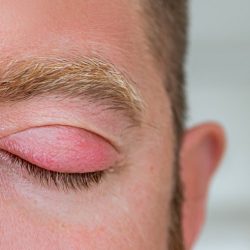
Ah, the stye—a small yet mighty irritant that has a knack for turning your day into a blink-filled battle. It’s like a zit’s overachieving cousin, but instead of popping up on your face, it parks itself on your eyelid and demands attention. Let’s dive into what styes are, what causes them, how to treat them, and why oral antibiotics are usually about as necessary as a kayak in a desert.
What Is a Stye?
A stye (or hordeolum if you’re feeling fancy) is a red, tender bump that forms on the edge of your eyelid. It’s caused by an infection in an oil gland or hair follicle, often courtesy of our old nemesis, Staphylococcus aureus. Styes can be external (on the edge of the eyelid) or internal (inside the eyelid, because of course, they had to be extra annoying).
What Causes a Stye?
Think of your eyelid as a bustling neighborhood of oil glands and hair follicles. When one of these gets blocked, bacteria move in and throw a rager. The result? Swelling, redness, pain, and a whole lot of irritation. Factors that can increase your risk of styes include:
- Poor eyelid hygiene (ahem, makeup hoarders).
- Touching your eyes with dirty hands.
- Chronic conditions like blepharitis (inflammation of the eyelid).
- Stress and lack of sleep (because life just isn’t fair).
Treating a Stye: Warm Compresses, Blephadex, and Patience
The good news? Most styes will go away on their own in a week or two. The bad news? They’ll test your patience while they’re at it. Here’s how you can speed up the process:
- Warm Compresses:
- Grab a clean washcloth, soak it in warm water, and hold it over the stye for 10-15 minutes, 3-4 times a day. This helps to unblock the gland and encourage drainage. It’s like giving your eyelid a spa day.
- Blephadex Wipes:
- These wipes contain tea tree oil and coconut oil, which can help clean your eyelid and reduce irritation. Think of them as a cleansing face mask for your eyelid—fancy, but effective.
- Avoid Squeezing:
- Yes, it’s tempting. No, don’t do it. Squeezing a stye can spread the infection and make things worse. Hands off, Dr. Pimple Popper wannabe!
- Over-the-Counter Pain Relief:
- If the stye is particularly bothersome, acetaminophen or ibuprofen can help take the edge off.
Why Oral Antibiotics Are Rarely Necessary
In most cases, a stye is a localized infection that doesn’t require systemic antibiotics. Here’s why oral antibiotics are usually unnecessary:
- The infection is superficial and can be managed with topical treatments.
- Overusing antibiotics contributes to antibiotic resistance (nobody wants to star in the sequel to Contagion).
When Are Oral Antibiotics Appropriate?
There are a few scenarios where your doctor might break out the big guns:
- Recurrent Styes: If you’re dealing with stye after stye, oral antibiotics may be used to tackle underlying bacterial issues.
- Cellulitis: If the infection spreads beyond your eyelid and causes redness, swelling, or pain in surrounding tissues, oral antibiotics become necessary.
- Immune Compromise: If you have a condition that affects your immune system, your doctor might prescribe antibiotics as a precaution.
Final Thoughts
Styes are a pain—literally and figuratively—but they’re rarely serious. With a little TLC (warm compresses, Blephadex, and self-restraint), most styes will wave the white flag and retreat. And remember, if you’re unsure or the stye isn’t improving, it’s always a good idea to consult an eye care professional. Now go forth and blink confidently, my friend!


